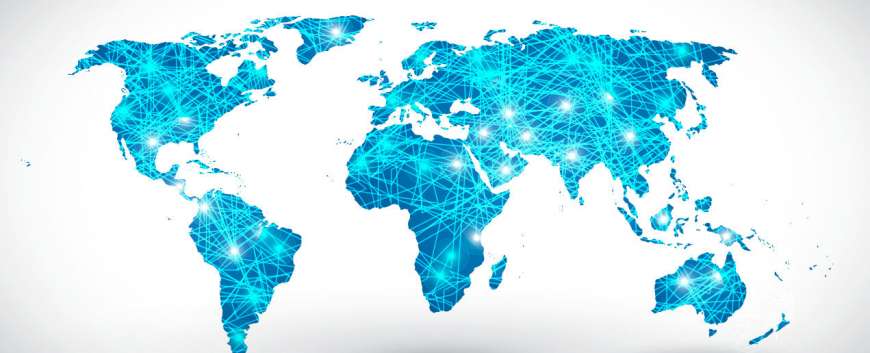Modern Communications: Signal Processing’s Vital Role in Connecting Communities
Top Reasons to Join SPS Today!
1. IEEE Signal Processing Magazine
2. Signal Processing Digital Library*
3. Inside Signal Processing Newsletter
4. SPS Resource Center
5. Career advancement & recognition
6. Discounts on conferences and publications
7. Professional networking
8. Communities for students, young professionals, and women
9. Volunteer opportunities
10. Coming soon! PDH/CEU credits
Click here to learn more.
Modern Communications: Signal Processing’s Vital Role in Connecting Communities
Waheed U. Bajwa, Dept. of ECE, Rutgers University-New Brunswick, NJ
Hamid Krim, Dept. of ECE, North Carolina State University, Raleigh, NC
Whether they know it or not, almost everyone in both the developed and developing worlds benefits from daily advances in signal processing. Our information age centers our activities around two key themes: ubiquitous connectivity and online social networking. And these themes are, in turn and not surprisingly, front and center themes in signal processing.
Signal Processing and Communications
In order to understand the profound role signal processing plays in our ability to always stay connected using smartphones, tablets, laptops, etc., consider the following hypothetical scenario. Suppose you are standing in the middle of a valley surrounded by tall mountains and your friend is standing at one of the edges of the valley. Now imagine communicating with your friend by shouting at the top of your lungs. What do you think would happen? Because of the large distance between you and your friend, chances are your friend would hear only some muddled sound and couldn’t make much sense out of the received message. This is quite a reasonable analogy to two electronic devices trying to communicate with each other using electromagnetic (EM) waves: the EM waves arriving at the intended device get muddled and must be “appropriately processed using signal processing tools” to be of any use at the receiving device.
The challenges involved in enabling ubiquitous connectivity between devices, however, go beyond this simple analogy. To get a realistic picture of modern communications, we have to add more details to our hypothetical scenarios. Specifically, imagine now that there are tens of other people standing near you in the middle of a valley, all of whom are simultaneously trying to communicate with their respective friends who are standing at different edges of the valley. And if this sounds like mayhem, consider the fact that the mountains around the valley may also cause echoes. Finally, by accounting for animal and bird sounds in the valley, we get a pretty clear picture of what it’s like to be in the “wild west” of ubiquitous connectivity among devices.
 Once we think of electronic communications through this lens, it seems rather remarkable we’re able to communicate at all, let alone stream movies on our electronic devices and video conference from our cell phones. But communicate we do! And signal processing plays a central role in enabling this electronic communication, from amplifying EM waves intended for a particular device, to canceling the EM waves coming from both non-intended transmitters and nuisance devices (think microwave ovens) as well as compressing messages to reduce the length of “shouting” needed to communicate messages (think of fitting an elephant in a refrigerator).
Once we think of electronic communications through this lens, it seems rather remarkable we’re able to communicate at all, let alone stream movies on our electronic devices and video conference from our cell phones. But communicate we do! And signal processing plays a central role in enabling this electronic communication, from amplifying EM waves intended for a particular device, to canceling the EM waves coming from both non-intended transmitters and nuisance devices (think microwave ovens) as well as compressing messages to reduce the length of “shouting” needed to communicate messages (think of fitting an elephant in a refrigerator).
Signal Processing and Networking
Ubiquitous connectivity is just one defining characteristic of the modern information age. “Networking” is another frequently used word in many usages and settings; this includes in social settings where we are trying to establish relationships with our peers, both professional and non-professional in nature. Indeed, each and every one of us knows what “connecting” with people means, as demonstrated by the staggering success of Facebook and other social venues.
It turns out that, in fact, such a notion of “network,” much like a road network adjoins cities as destination sites or nodes, permeates all living creatures as well as physical systems such as computer systems sitting at four corners of the world seamlessly sharing and exchanging data and information; chemical processes, as in cells in a living organism where chemical entities communicate by actively exchanging chemical molecules to accomplish specific tasks; and biological processes such as gene regulatory networks in DNA, which make up proteins in living organisms.
A natural question arises about how all these processes are similar at some level, and what this underlying mechanism, common to all these networks, is. Signal processing helps describe this mechanism through the language of mathematics, and provides the tools necessary to understand the elements that are exchanged among the nodes of these network-structured "organisms."
To better understand this idea, just imagine how the news that one won the lottery gets around the circle of friends and beyond. It may start with a “spoken word,” which as a sound can be captured by a microphone, for instance. This is subsequently turned into electrical energy which may be carried by a telephone, computer or other transmitting device to another individual with a receiving/transmitting device, who may, in turn, be engaged in another conversation. A high-level view of the propagation of this information is similar to what’s taking place over Facebook had the news started with a post by the lottery winner/friend, and subsequently read by members of the circle of friends, and possibly reposted by another friend with yet again another circle of friends, making information spread even wider. Signal processing makes this information spread possible, ensures that the structure of such a network is sound, and also helps us determine when a breakdown in the spread of information may occur. The same tools from signal processing for networking help governments track the spread of radical ideologies within social networks, possible spread of an infectious disease (think Zika virus) within communities, and help them take law enforcement and quarantine decisions.
Signal processing is at the helm of modern communications. Without it, our ability to communicate and connect with others would be greatly challenged. Next time you pick up your cell phone or log onto to your social media account, stop and think of what’s working behind the scenes to make that possible.
SPS on Twitter
- DEADLINE EXTENDED: The 2023 IEEE International Workshop on Machine Learning for Signal Processing is now accepting… https://t.co/NLH2u19a3y
- ONE MONTH OUT! We are celebrating the inaugural SPS Day on 2 June, honoring the date the Society was established in… https://t.co/V6Z3wKGK1O
- The new SPS Scholarship Program welcomes applications from students interested in pursuing signal processing educat… https://t.co/0aYPMDSWDj
- CALL FOR PAPERS: The IEEE Journal of Selected Topics in Signal Processing is now seeking submissions for a Special… https://t.co/NPCGrSjQbh
- Test your knowledge of signal processing history with our April trivia! Our 75th anniversary celebration continues:… https://t.co/4xal7voFER











